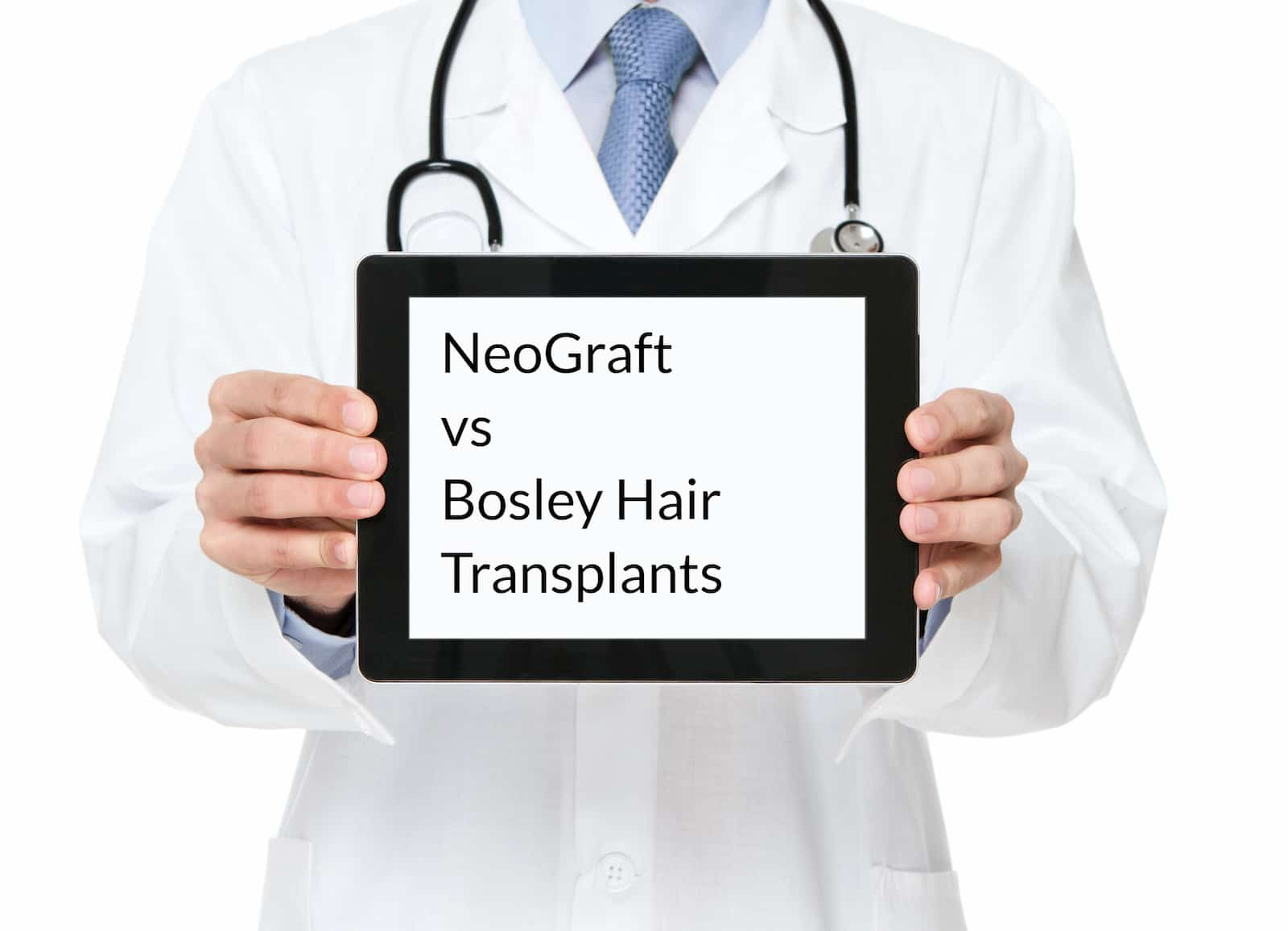Around 80 million American men and women have thinning hair or male/female pattern baldness, according to the Amercian Academy of Dermatology (AAD). And, many are searching for a solution for hair loss to regain their confidence. The NeoGraft® hair restoration system is a minimally invasive hair transplant procedure enabling you to obtain the hairline you desire and deserve.
About the Neograft Hair Transplant Procedure
The Houston NeoGraft procedure uses Follicular Unit Extraction (FUE) to expedite follicle harvesting during the hair transplant. It drastically improves the speed and accuracy over manual extraction instruments used previously.
Men and women are choosing the NeoGraft FUE procedure for tackling their hair loss problem because of it:
-
Uses a minimally invasive hair restoration procedure (no staples or stitches).
-
Provides a quick recovery time (in just a few days you can resume normal activity).
-
Doesn't involve a scalpel so there's little-to-no discomfort.
-
Provides a natural-looking hairline with no linear scar.
-
Comes with several financing programs to meet any patient's hair restoration budget.
The NeoGraft FUE method offers patients many benefits, including:
-
It’s a safe and minor procedure.
-
It offers fewer complications and nominal bleeding when compared with the “strip” method.
-
It provides a short recovery time.
-
The hair surgeon performs the procedure with local anesthetic and therefore the procedure requires no intra-muscular or intravenous sedation.
-
There are no scalpel incisions, linear scarring or sutures and patients experience very little-to-no discomfort or pain.
-
The NeoGraft system also helps fix noticeable linear scars “strip” surgeries previously left behind.
The NeoGraft FUE procedure is another option patients have available to them who are looking to use the FUE procedure to tackle their issues with hair loss. Individuals who are eligible and good candidates for the FUE procedure will likely also be eligible and good candidates for the NeoGraft procedure.
Some patients and doctors will conclude the NeoGraft system is a patient’s best option for addressing thinning hair or hair loss, especially if they’re concerned the donor site might not have the ability to yield sufficient follicular units and therefore not be able to deliver the outcome desired. This is due to the NeoGraft method favoring an automated individual follicular unit removal system, ensuring twisting and pulling doesn’t damage the follicles.
Those thinking about having the NeoGraft procedure done should also keep in mind that no level of automation is a substitute for an experienced and skilled hair transplant surgeon’s handiwork, like that of Dr. Bradford S. Patt, MD, FACS, no matter what robotic hair transplant system being used, including NeoGraft.
While the NeoGraft procedure does increase the chances of optimal donor site follicle yield, a hair transplant surgeon’s skilled hands remain most effective when it comes down to fully utilizing a patient’s donor site. They’re also better able to provide patients with a more natural-looking hairline while adding substantial volume to balding and thinning areas.
How NeoGraft Hair Transplant Works
Just a few steps can get you a healthy head of hair. The steps include:
- Removal of Donor Hair: NeoGraft removes hair from the back of your head in the donor area where the hair resists testosterone genetically. This is referred to as your donor hair.
- Follicular Unit Extraction (FUE): A qualified hair transplant surgeon then extracts each graft with the same length and diameter consistency, resulting in a drastically larger take rate.
- Recipient Sites Creation: The surgeon then creates recipient sites in the correct direction, angle and orientation based on your specifically designed artistic hair transplant plan.
- Hair Graft Placement: The surgeon separates the follicular units carefully by size and then transplants the grafts into your thinning and balding scalp areas. They meticulously harvest each graft as it naturally occurs, implanting each separately to ensure you get the best results possible.
Neograft Recovery Time and Process
Following a standard hair transplant surgery, most individuals worry about recovery and length of downtime. Patients can usually resume their normal activities following the NeoGraft procedure within a few days. In fact, many patients are able to go back to work the very next day following their procedure.
The transplanted hair will be rooted safely under your scalp after 7 to 10 days and your hair will even be covering the donor area by then as well. After that, the donor site where the NeoGraft procedure was performed will be nearly undetectable. Most patients claim to experience little to no pain during the NeoGraft process and recovery.
Neograft Hair Transplant Results
With the NeoGraft hair transplant procedure, you can expect superior results. Both men and women can wear their hair short or long with natural-looking results. It's a simple grafting process. As mentioned, the surgeon takes hair follicles from your donor area where the hair naturally continues growing. Your transplanted hair follicles are living tissues which grow cyclically.
After the hair transplant surgeon implants the normal hair follicle into your balding or thinning area, the grafted hair stays in place for several weeks before it sheds — an important and normal part of the new growth process. Once its shed, new growth starts usually in three to four months and your hair will keep on growing normally, leaving you with natural and healthy results.
NeoGraft extracts total individual hair follicles precisely using pneumatic controls. The surgeon can then transplant these follicles immediately to the scalp areas selected. NeoGraft offers absolute precise harvesting and placement to achieve your desired results. You remain comfortable as the surgeon removes each follicle. And, after the procedure, you walk away with a head of natural-looking hair you can wear any way you like, because it’s your natural hair.
Individuals can expect fuller results who have:
-
Greater hair density
-
More donor hair
-
Greater hair fullness
While hair transplantation may provide you with great, natural results, you still need reasonable cosmetic goals because it may not restore your hair to a teenage density. The hair transplant surgeon will determine how much coverage you require to provide you with your desired appearance.
Schedule Your Neograft Hair Transplant Consultation in Houston with Dr. Patt
During the natural aging process, hair loss can become emotional for some individuals leaving them hopelessly searching for ways to slow down this process. For most individuals, having a healthy-looking, full head of hair symbolizes attractiveness, youth and allure both professionally and personally. Because of this, it’s essential to understand the types of impact a hair transplant procedure can have on your everyday interactions and life.
NeoGraft's minimally invasive system offers people a distinct hair loss solution, allowing them to have the natural head of hair they desire with minimal downtime for recovery and no linear scarring. And, since the NeoGraft hair restoration procedure is virtually unnoticeable, it can be your secret.
Don’t hesitate, contact Dr. Bradford S. Patt, MD, FACS at Houston Center for Facial Plastic Surgery to schedule your NeoGraft hair transplant consultation in Houston today. He is recognized in leading physician listings of “Super Doctors® and “Top Docs®” of Houston for 11 straight years. He’s been practicing for two decades and is board-certified in otolaryngology, head and neck surgery, and facial plastic and reconstructive surgery.
Call the office of Dr. Patt today at (281) 649-7170 for your Neograft hair transplant consultation or click here to request a consultation today!






